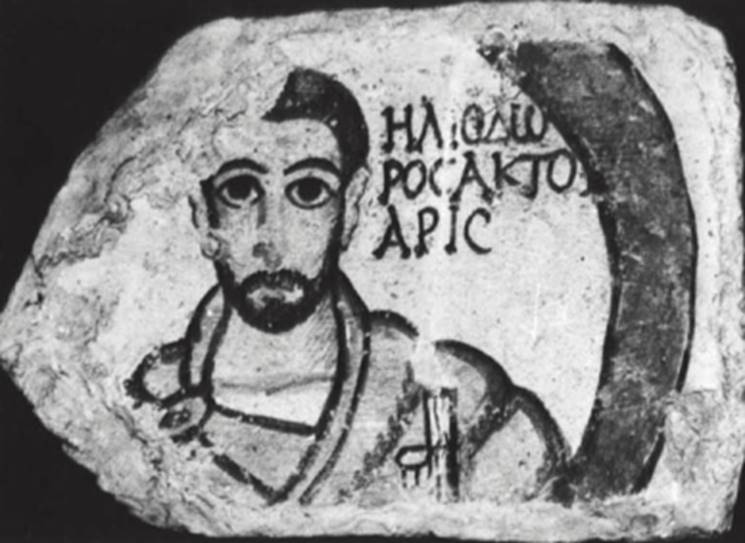Ceiling tile with portrait of the actuarius Heliodorus. Dura Europos, Syria, about 255. Fresco secco
This ceiling tile found in the House of the Roman Scribes shows the head and shoulders of a bearded man. Hair and beard are brown, with short vertical strokes texturing only beard and mustache; flesh is pink, and eyes black with white eyeballs. White undergarment with pink border is visible beneath heavy yellow robe outlined in black on dark brown; leaf pattern or fringe crosses left shoulder. In front of this shoulder is upper part of cylindrical white pen-and-ink box, outlined with black. To right of the head a painted inscription gives the subject's name and position: HAIOAOOPOC AKTOVAPIC.

The actuarius was a noncommissioned officer of the Roman army, charged with record-keeping duties comparable to those of a notary. Heliodorus was evidently one of a group of officers who requisitioned an enlarged private house near the main West Gate of Dura during preparations for the Persian siege under Valerian and Gallienus. When the house was demolished to strengthen the fortifications (like the adjoining synagogue), work was still in progress in decorating the room in which this tile was found: a mold for these plaster "bricks" was lying on the floor.
The use of ceiling tiles as coffers set into wood-beamed ceilings was common throughout the Roman world; many rooms in Dura had such ceilings. The placing of images of the occupants in such ceilings is less well documented.
In addition to a number of tiles with fruit and floral designs, this ceiling included' heads of divinities and of mortals; aside from Heliodorus and another soldier—the tesserarius Ulpius Sil- vanus—several citizens of Dura who may have been owners of the requisitioned house. Four more portrait tiles, apparently removed from the same ceiling, were among seven tiles found buried under the floor of an adjacent room. These portraits should probably be related to the personages depicted in the coffers of the Constantinian ceiling discovered in a room beneath the cathedral of Trier (Lavin, 1967, pp. 100—101).
The portrayal is simple and craftsmanlike, the modeling reduced to linear elements of shading; the style is similar to that of apparently later Egyptian mummy portraits (no. 266), but closer analogies exist much nearer to Dura, at Palmyra (now Tadmur) (Rostovtzeff et al., 1936, p. 284). The short-cropped beard, painted as if stubbled, is in accord with the imagery of the soldier- emperors of the third century (no. 1), with whom a subordinate officer of the border armies would naturally identify.
Bibliography: Rostovtzeff et al., 1936, pp. 265-304, esp. pp. 291-292.
Date added: 2025-07-10; views: 167;
